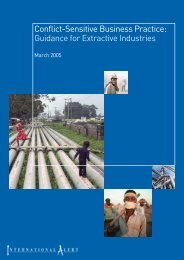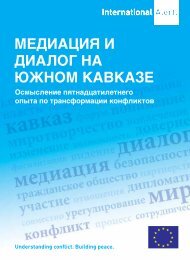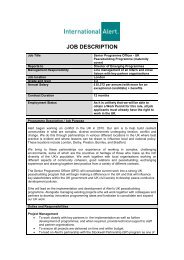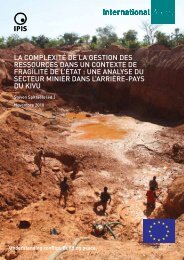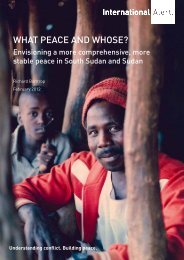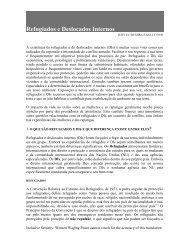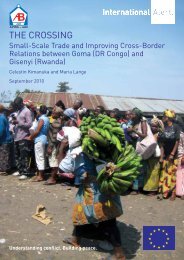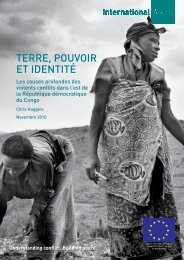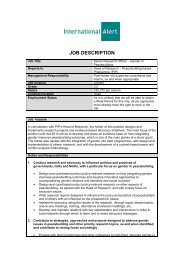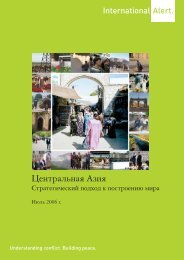Walking in the Dark: informal Cross-border trade ... - International Alert
Walking in the Dark: informal Cross-border trade ... - International Alert
Walking in the Dark: informal Cross-border trade ... - International Alert
Create successful ePaper yourself
Turn your PDF publications into a flip-book with our unique Google optimized e-Paper software.
<strong>Walk<strong>in</strong>g</strong> <strong>in</strong> <strong>the</strong> <strong>Dark</strong>: Informal <strong>Cross</strong>-<strong>border</strong> Trade <strong>in</strong> <strong>the</strong> Great Lakes Region<br />
13<br />
3. “Interviewer” bias. The op<strong>in</strong>ions of <strong>the</strong> <strong>in</strong>terviewers <strong>the</strong>mselves and <strong>the</strong>ir supervisors may<br />
<strong>in</strong>fluence <strong>the</strong> results, for example when <strong>in</strong>terviewers verbally <strong>in</strong>dicate which answer is<br />
“correct”. We tried to m<strong>in</strong>imise this bias dur<strong>in</strong>g tra<strong>in</strong><strong>in</strong>g us<strong>in</strong>g role play.<br />
4. “Respondent” bias. It may be <strong>in</strong> <strong>the</strong> <strong>in</strong>terests of respondents to provide certa<strong>in</strong> false answers<br />
<strong>in</strong> order to benefit at a later stage. The <strong>in</strong>terviewers expla<strong>in</strong>ed <strong>the</strong> objectives of <strong>the</strong> study to<br />
each respondent.<br />
5. “Confidentiality” bias. Confidentiality and anonymity were applied throughout <strong>the</strong><br />
<strong>in</strong>terviews. To ensure participation was voluntary, <strong>the</strong> <strong>in</strong>terviewers were required to expla<strong>in</strong><br />
<strong>the</strong> difference between <strong>the</strong>ir research and <strong>the</strong> various services related to taxation operat<strong>in</strong>g<br />
on <strong>the</strong> Congolese <strong>border</strong>.<br />
6. “Evaluation of product quantity” bias. Dur<strong>in</strong>g <strong>the</strong> <strong>in</strong>terviews, <strong>the</strong> <strong>in</strong>terviewers were required<br />
to evaluate <strong>the</strong> quantity (weight, number of litres, number of articles, etc.) of products be<strong>in</strong>g<br />
exchanged. This task was made easier by several practical exercises carried out dur<strong>in</strong>g <strong>the</strong><br />
tra<strong>in</strong><strong>in</strong>g sessions.<br />
7. “Informality” bias. We considered <strong>the</strong> issue of receipts to be an <strong>in</strong>dication of <strong>the</strong> legal<br />
nature of taxes. As expla<strong>in</strong>ed below, although this <strong>in</strong>dicator functioned well, <strong>the</strong> amount of<br />
<strong>in</strong>formal taxes actually paid is much higher for several reasons (<strong>the</strong> receipts <strong>the</strong>mselves may<br />
be unofficial, for example).<br />
8. At <strong>the</strong> Bukavu and Arua sites, we lost one day’s work follow<strong>in</strong>g an adm<strong>in</strong>istrative delay <strong>in</strong><br />
secur<strong>in</strong>g authorisation from <strong>the</strong> <strong>border</strong> authorities.<br />
To reduce <strong>the</strong> risk of <strong>the</strong>se biases, we:<br />
• devoted time and effort to choose and tra<strong>in</strong> experienced <strong>in</strong>terviewers;<br />
• organised a prelim<strong>in</strong>ary study as well as <strong>in</strong>tensive supervision dur<strong>in</strong>g <strong>the</strong> real study;<br />
• rigorously verified all questionnaires and offered on-<strong>the</strong>-spot feedback to <strong>in</strong>terviewers before<br />
<strong>the</strong>y returned to <strong>the</strong> field;<br />
• ensured that our encoders entered <strong>the</strong> data <strong>the</strong> day after it was collected and could be <strong>the</strong>refore<br />
checked for any errors;<br />
• asked an experienced researcher to carry out rigorous qualitative analysis, i.e. detailed, on<strong>the</strong>-ground<br />
research.<br />
This report beg<strong>in</strong>s by analys<strong>in</strong>g <strong>the</strong> profile of <strong>the</strong> <strong>trade</strong>rs <strong>in</strong> terms of <strong>the</strong> percentage of women,<br />
<strong>the</strong>ir level of education, age, nationality and civil status (Chapter 2). We go on to analyse <strong>the</strong><br />
economic importance of small cross-<strong>border</strong> <strong>trade</strong>, commercial exchanges and <strong>the</strong> types of<br />
products sold by men and women (Chapter 3). Chapter 4 provides an analysis of <strong>trade</strong>rs’ capital<br />
and profits, pay<strong>in</strong>g particular attention to differences based on gender. We <strong>the</strong>n exam<strong>in</strong>e <strong>the</strong><br />
difficulties relat<strong>in</strong>g to formal and <strong>in</strong>formal taxes at <strong>the</strong> different <strong>border</strong> locations (Chapter 5).<br />
Chapter 6 relates to <strong>the</strong> problems encountered by <strong>trade</strong>rs, with a particular focus on problems<br />
experienced by female <strong>trade</strong>rs and relations between <strong>trade</strong>rs from <strong>the</strong> different countries. Chapter<br />
7 exam<strong>in</strong>es <strong>the</strong> solutions as perceived by <strong>trade</strong>rs and offers a discussion about <strong>the</strong> specific problems<br />
associated with <strong>the</strong> <strong>in</strong>formal nature of much of <strong>the</strong> <strong>trade</strong> which takes place. F<strong>in</strong>ally, a conclusion<br />
and recommendations are provided <strong>in</strong> Chapter 8.





